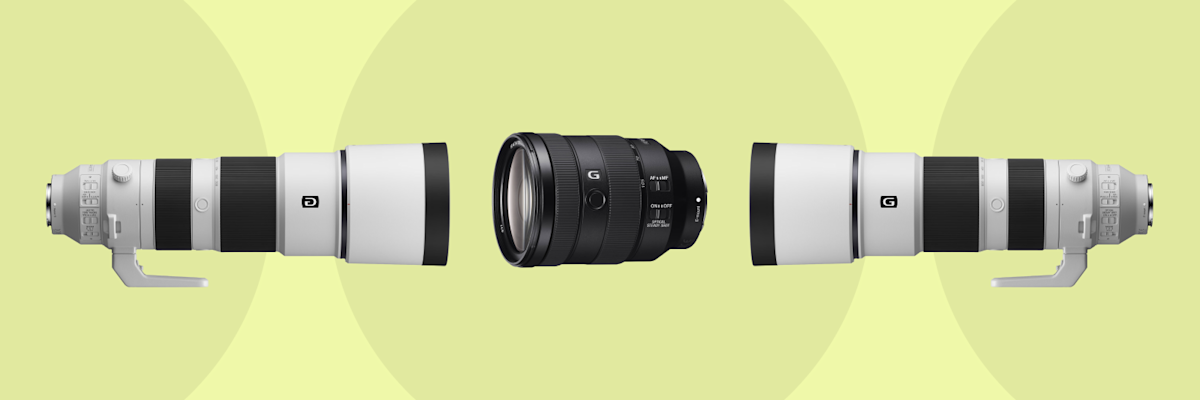Are you looking for a new lens for your camera but unsure which ones will fit? The world of camera lenses can be confusing, especially for beginners. You might end up renting a lens that doesn’t fit your camera, and that’s a frustrating (and expensive) mistake. But don’t worry—Grover has you covered so YOU only worry about the creativity.
Understanding Lens Mounts
Your camera belongs to a specific system that uses a particular lens mount. The lens mount is the connection between the camera body and the lens. If the lens and the camera have the same mount, they’ll fit together seamlessly. If they don’t, you might need an adapter, or they might not be compatible.
Generally, cameras and lenses from the same manufacturer share the same mount. But it’s not always that simple. Some brands have multiple mounts, and not all lenses are interchangeable between different systems. Meanwhile, third-party lens manufacturers like Sigma, Tamron, and Tokina produce lenses for various mounts, so you need to choose the right version.
Common Lens Mounts
Here’s a quick overview of some popular mounts:
Sony FE-Mount – Used for Sony full-frame mirrorless cameras.
Sony E-Mount – Used for Sony APS-C mirrorless cameras.
Canon RF Mount – Used for Canon mirrorless cameras.
Nikon Z-Mount – Used for Nikon mirrorless cameras.
F-Mount (Nikon) – Used for Nikon DSLR cameras.
EF-Mount (Canon) – Used for Canon DSLR cameras.
Before renting a lens, check your camera’s mount type to ensure compatibility.
Sensor Size and Crop Factor
Even if a lens fits on your camera, you still need to consider the sensor size. Cameras typically have one of the following sensor sizes:
Micro Four Thirds (MFT) – 17 × 13 mm
APS-C – Approx. 24 × 18 mm
Full-frame (also called 35mm format) – 36 × 24 mm
Medium format – 44 × 33 mm or larger
Some lens mounts (like Micro Four Thirds) only work with one sensor size. Others, like the Sony E-mount and Canon RF-mount, support both APS-C and full-frame sensors. However, using a lens designed for a smaller sensor on a larger sensor can cause image quality issues and cropping effects.
For example, if you mount a Sony FE (full-frame) lens on a Sony APS-C camera, the image will be cropped by 1.5x. That means a 50mm lens will give you a field of view equivalent to 75mm on a full-frame camera.
Five Popular Lenses and Their Compatibility
To illustrate lens compatibility, let’s take a look at five popular lenses and where they fit best.
1. Sony 200-600mm f/5.6-6.3 G OSS (Sony FE-Mount)
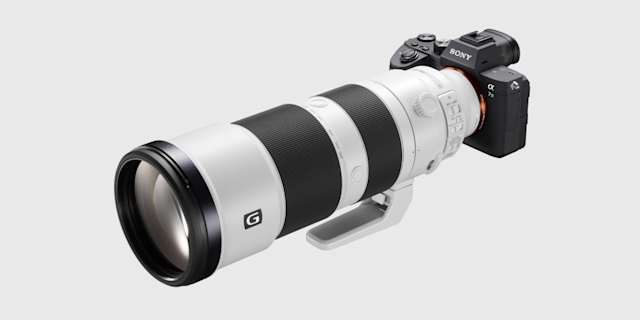
Compatible Cameras : Sony full-frame (FE-mount) mirrorless cameras like the Sony A7 series and A9 series.
APS-C Compatibility? Yes, but with a 1.5x crop factor (equivalent to 300-900mm).
Best Use : Wildlife and sports photography.
This lens is a fantastic choice for wildlife photographers who need an extreme zoom range.For example, Birds of prey like perching, but they will run away from you faster than you getting close to them. this lens allows you to snap the moment closer without exactly being next to the animal. It fits perfectly on Sony’s full-frame mirrorless cameras, but you can also use it on an APS-C model like the Sony A6600 with a slight crop. (or use the crop factor to get even further reach)
2. Canon RF 50mm f/1.8 STM Lens

Compatible Cameras : Canon EOS R series (RF-mount mirrorless cameras).
APS-C Compatibility? Yes, with a 1.6x crop factor, 80mm equivalent field of view, perfect for portraits.
Best Use : Portraits, street photography, and low-light photography.
This is one of the most affordable and popular lenses for Canon RF users. It delivers sharp images and a beautiful background blur, making it ideal for portraits and everyday shooting.
3. Sony SEL 70-350mm f/4.5-6.3 G OSS (Sony E-Mount)
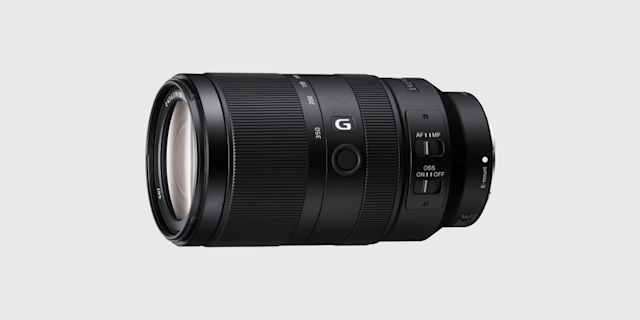
Compatible Cameras : Sony APS-C (E-mount) mirrorless cameras like the Sony A6400.
Full-frame Compatibility? No, but you can mount it in crop mode.
Best Use : Wildlife and sports photography.
Since this lens is designed for Sony APS-C cameras, it provides an equivalent field of view of about 105-525mm on a full-frame system, giving you a long reach in a compact package.
4. Sony SEL 70-200mm f/4 G-Series (Sony FE-Mount)
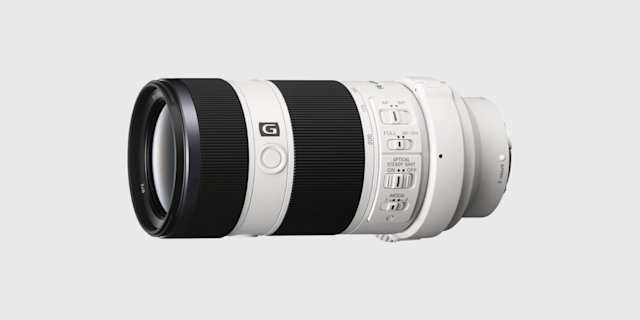
Compatible Cameras : Sony full-frame (FE-mount) mirrorless cameras like the Sony A7 III.
APS-C Compatibility? Yes, with a 1.5x crop (105-300mm equivalent).
Best Use : Portraits, sports, events, and travel photography.
This is a high-quality telephoto zoom lens that’s great for capturing action, portraits, and even landscape details. It’s a lightweight alternative to the more expensive f/2.8 version, making it a favorite among travel photographers.
5. Sony FE 24-105mm f/4 G OSS (Sony FE-Mount)
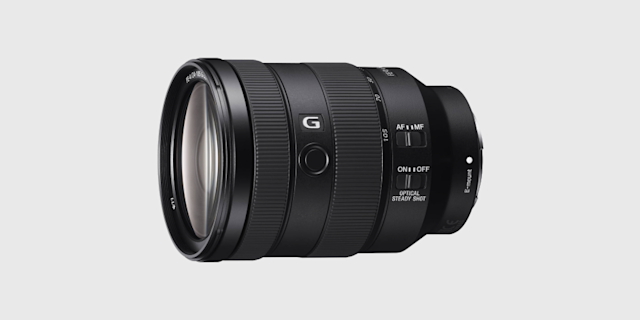
Compatible Cameras : Sony full-frame (FE-mount) mirrorless cameras.
APS-C Compatibility? Yes, with a 1.5x crop (36-157mm equivalent).
Best Use : Versatile all-in-one travel and everyday lens.
This lens is a fantastic all-around option for full-frame users. It provides a useful zoom range, image stabilization, and consistent f/4 aperture, making it a go-to choice for travel and event photography.
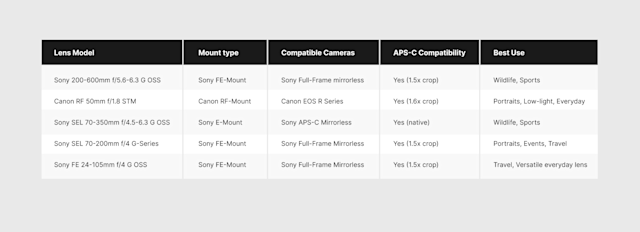
Lens Adapters: Making Non-Compatible Lenses Work
If a lens doesn’t fit your camera, you may be able to use an adapter. This is especially common when switching from DSLR to mirrorless cameras. For example:
Canon EF to RF adapters allow you to use older Canon DSLR lenses on newer Canon RF-mount mirrorless cameras.
Nikon F to Z adapters let you mount Nikon DSLR lenses on Nikon Z mirrorless cameras.
Sony A to E adapters allow Sony A-mount DSLR lenses to work on Sony mirrorless cameras.
However, adapted lenses might not perform as well as native lenses. Autofocus can be slower, and some features (like image stabilization) may not work properly. If you’re new to photography, it’s best to stick with native lenses to avoid compatibility issues.
Conclusion
Choosing the right lens for your camera doesn’t have to be overwhelming. The key is to match your camera to not only the purpose you need but also what will enable you to explore new ways of snapping a photo or film the moment.
By understanding mounts, sensor sizes, and lens options, you can make an informed choice and avoid costly mistakes. Whether you need a superzoom for wildlife, a fast prime for portraits, or an all-around zoom for travel, a lens out there is perfect for your needs. Happy shooting!
